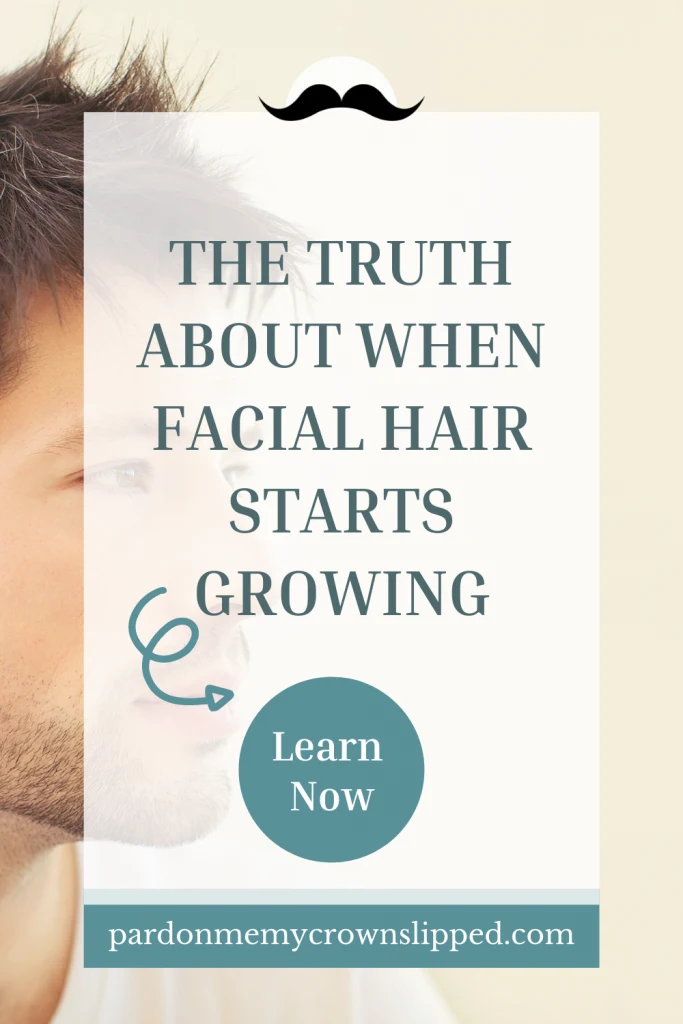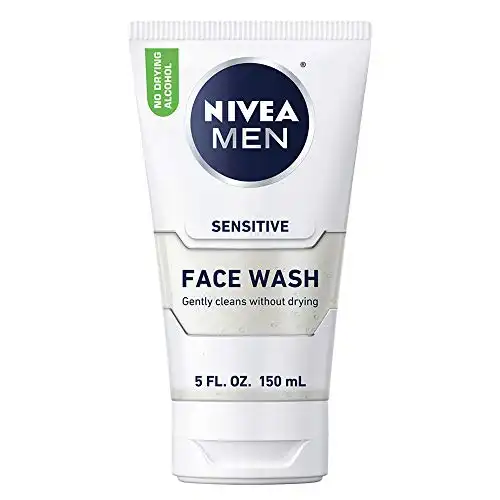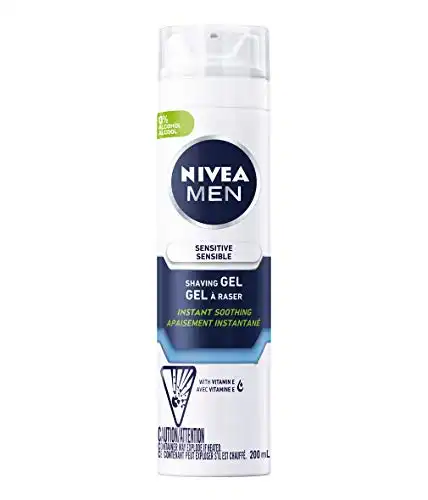Puberty is an exciting time for boys. There is a lot happening and they really want to know when does facial hair start growing.
For most boys, they get particularly excited at the first sign of facial hair.
From that first time you think your tween’s upper lip has dirt on it, to learning how to shave, I’ll go over some tips to help him (and you), figure it out together).

This post contains affiliate links. I will earn a commission at no additional charge to you if you make a purchase using my links. Click here to see my full disclosure policy.
At what age will facial hair start growing?
Boys begin growing facial hair at different times.
Some boys start as young as eleven. Often these boys end up shaving when they’re in middle school or high school.
Other boys don’t get their first sign of facial until they’re in their late teens or their very early twenties. And some men do not produce much facial hair at all.
Facial hair starts when a hormonal change triggers to send more testosterone into the body.
This type of hair starts to grow under the chin and on the upper lip when a boy starts puberty.
What stage of puberty is facial hair?

The average age when puberty begins is around 11 for boys, and 10 years old for girls.
Teenage boys typically start developing facial hair in the later stages of puberty or adolescence, around fifteen years of age, and most do not finish developing a full adult beard until around eighteen or later.
In this post, the focus is on boys, but it’s not just boys who experience facial hair.
Girls do too, but it’s usually much lighter and not as noticeable.
Girls of Latina, Hispanic, or Native American heritage tend to begin developing facial hair earlier than other girls. And it’s typically darker.
What age does facial hair fully develop?

As a guy progresses into their late teens and early twenties, the hair on their cheeks thicken and can be seen when shaving.
This is when a man’s facial hair really starts to come in. It won’t appear as full as it will when they are older, but it will begin to form a more complete beard.
The good news is for most men they won’t have a patchy beard after this. For those that do, if they don’t like it, they can simply maintain a close shave.
Shaving can be a rite of passage for tween and teen boys, but it’s also a big decision. It’s important to talk with your son about when he should start shaving and what kind of products are available to him.
Shaving is not just about the hair on your face.
It’s also a good way to learn about taking care of oneself and instill proper grooming habits.
Shaving can be an important step in developing a sense of independence.
There are many different ways to shave, so it’s important to find the method that works best for your son.
He may want to try a few different methods before settling on one.
Once your son has decided on a shaving method, make sure he uses quality products that will protect his skin.
What Teen and Tween Boys Need to Know About Shaving

It can be very difficult when it comes to shaving his face for the first time, but there are things that mom or dad can do to help make this task much easier for boys.
Teenage boys should learn:
- when and how to use shave cream
- how to handle the razor safely
- cleaning and storing a razor
- cleaning up after shaving
- what to do when they cut themselves
- when to change the blade on their razor
- how to take care of their skin now that they’re shaving
- when it’s appropriate to start shaving regularly
- what to do about skin reactions like razor burn and in-grown hairs
When and How to Use Shaving Cream
- Never dry shave or use soap
- Wet face first, warm water especially in the shower will soften hair
- Good shaving cream or gel applied liberally will help protect sensitive skin from razor burn
How to Handle a Razor Safely
- Always go against the growth of hair to prevent in-grown hair and razor burn
- Slow going is key to safety and a good shave
- Navigating around chin and adam’s apple takes time, patience and practice
- Never share razors
Cleaning and Storing a Razor
- Always clean it well after shaving so it isn’t clogged with hair
- Shaving gels are particularly prone to clogging the razor
- Always dry it when done to avoid rusting
Cleaning Up After Shaving
As moms, we often see the remnants of grooming in sinks and showers. Reminding them to be respectful of others gets them in the habit of tidying up.
- Always clean up any loose hair
- Rinse the sink well of hair and shaving cream
What to Do When They Cut Themselves Shaving
First-time and experienced shavers alike will at some point nick themselves. It’s important to know what to do.
- Press a warm washcloth against the cut for 30 seconds, until bleeding slows or stops. Warm water will help clean the cut and slow blood loss.
- Apply a witch-hazel-based toner or other alcohol-free aftershave to disinfect the wound.
- Apply topical anti-bacterial or vaseline to keep germs out
When to Change the Blade on a Razor
- A sharp razor is less likely to cut
- After 4-5 uses a blade will become dull and are more likely to nick the skin
- Always inspect the razor before shaving, replace if it has any rust
How to Take Care of Their Skin Now that They’re Shaving
Sharp blades and even worse dull ones can wear off the outermost layer of skin.
Teenage skin is already sensitive. It’s still relatively new and is going through a multitude of changes. Adding a shaving routine on top of that can really be a lot.
They should wash their face before and after shaving.
Following up shaving with a really good skincare routine is important to help the healing process.
Teenagers with acne will want to follow specific instructions for those conditions.
Aftershaves are products designed just for this purpose. They contain antiseptics that heal the skin surface. Most also have an anesthetic that numbs the area.
Some contain skin moisturizers and fragrances.
As much as teenage boys love fragrances, they are better off with an aftershave that is a good toner and then follow up with a skin moisturizer forgetting the fragrances when it comes to their face.
The toner, or astringent ingredient, will help close off the semi-opened skin pores so that bacteria can’t penetrate easily. Often these are alcohol-based so they will sting a bit. Using witch hazel instead can provide an excellent alcohol-free alternative.
Following up with a moisturizer designed for teenage skin is the best way to make sure the shaving process doesn’t dry out their face.
There are skin care products designed just for teens, but keep in mind, shaving adds a different component so they made need to try something like this one that offers a full 5-step skincare routine just for men with sensitive skin.
How to Handle Skin Reactions
Prevention is best but skin reactions happen sometimes. Allergic reactions to products or improperly using the razor. Things like razor burn and in-grown hairs.
Razor bumps from in-grown hair look like small pimples. Razor burn looks more like red streaks or blotches across the skin.
The best product for razor burn is aloe vera. From the aloe vera plant, the gel acts as a moisturizer, soother, antiseptic, antiviral, and anti-inflammatory.
Vitamin E oil may also be applied directly to razor burn to help with the healing process.
What about beard balms, beard oil, beard wax?

There has been a surge in male grooming products in the last few years.
Beard oils can certainly provide much-needed moisture to skin that has been shaved. However, oils can sometimes be too much particularly for teens who already combat oily skin.
Balms are an even heavier version and beard wax is more for styling than moisturizing.
Unless your teenager has a good face full of hair, these products are best left for mature skin.
When It’s Appropriate for Teen Boys to Start Shaving Regularly
Any teen who has begun to see facial hair can start to shave.
In the beginning, (or ever) it’s not particularly necessary.
Some boys like to do it to feel more mature. Some who sprout facial hair early may want to hide it so they don’t feel different.
It’s really a matter of their comfort level. There should be no shame in what they decide. Their body, their choice.
What if my teenager wants to shave?
Unless they have very thick facial hair, they don’t have to shave every day at first.
There will be plenty of time for daily shaving when they’re an older teen or young adult. As they get older, their hair will start to come in much faster, requiring more frequent shaving. Some jobs still require a clean shave.
How to teach a boy to shave?
Teens and tweens, well people in general usually learn really well by watching.
If you’re a mom, (or a dad) who doesn’t shave. How about teaching the steps by watching this guy?
Rob Kenney is the internet sensation, YouTube host of “Dad, How Do I?”
He has made it his mission to offer fatherly advice on how to do everyday things like changing the oil in your car, tying a tie and you guessed it – shaving.
Does shaving increase hair growth?
You may have heard that you shouldn’t shave when you start to grow facial hair.
The reality is that it’s usually best to wait until the fullness of a beard starts to thicken before shaving.
This may be sixteen or it might be twenty-four, depending on when their body started growing hair during the teenage years.
At what rate does facial hair grow?
Facial hair grows at an average of about 1/8 of an inch per month, or around 9 inches per year.
Some Boys Want to Know: How can I grow beard faster?

If they’re still teenagers, they may just have to wait until they grow up a bit more.
But if they’re a teen who already has quite a bit of facial hair already, there are some things you can do to make your beard grow faster.
You can try massaging your face with castor oil, which is said to increase growth when rubbed on the roots of your hair follicles. People with oily skin may not want to try this method.
The last thing they can do is let their beard fully grow out and then shave when it gets to a certain length.
Beard oil may also help when growing or maintaining a beard for teenagers who have dry skin from shaving often.
The truth for when facial hair starts growing – when it’s ready.
Finally, if you think your son is ready, talk with him about shaving and help him get started on the right foot.
Shaving can be a positive experience for both of you if you take the time to prepare him for it.
Give it a try today!
Frequently Asked Questions
At what age do you have a full beard?
It takes testosterone levels over 100 nanograms per deciliter to have a full beard when you are an adult. The average age when men have this level is around 18 years old for Caucasian men.
Can a 14 year old grow facial hair?
In some cases, boys can see a little bit of hair when they are 14 years old. Around 98% of boys get signs of facial hair when they start puberty. Around 70% get a mustache and around 30% grow sideburns without having a full beard when they enter into puberty between the ages of eleven to fourteen.
Should a 17 year old have facial hair?
It can take time for facial hair to fully come in at the rate it does when men enter later stages of puberty. Some men don’t have much facial hair when they are in their mid-to-late teens, but do when they are in their early twenties.
When does facial hair start growing?
Facial hair starts growing when puberty begins. For some, that’s when they’re eleven or twelve years old and for others, it’s when they turn eighteen. Even when facial hair starts to grow, it may not be visible until puberty has advanced more.
Why can’t I grow a beard at 18?
You may still have a few years to grow when you’re 18, but you will probably see more growth when you are 20 or 21.
Can a 12 year old use hair removal cream?
When used correctly, all are safe and none have age restrictions. No hair removal method is permanent, although some do last quite a while. Some hair removal techniques can be painful. Carefully consider the pros and cons of each method.
Can a 12 year old get laser hair removal?
If your child is under the age of 12, it’s advisable to hold off on laser hair removal until they’re a bit older. At 12 and younger, they may not even have all the hair they’re going to have until they finish puberty.




